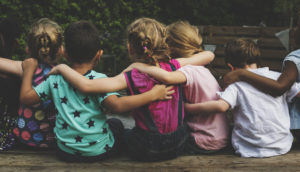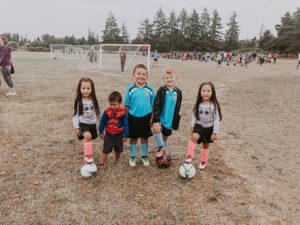Social Emotional Connections

One of the main reasons I enjoy working in early learning is the strong focus and importance of social emotional development. Social emotional curriculum, support and education has become more normalized over the years. Which makes sense, we are only humans and emotions are a big part of our biology. Knowing how to regulate our emotions properly and teach skills to our littles is possible.
Growing up I do not recall very much education around feelings. My dad was good at explaining how to show empathy by asking us to think of others and not just ourselves through storytelling. Labeling feelings was not something I regularly did and on the rare occasion, that I did label feelings it was not in the best-structured statements. I used to use phrases like, “You made me mad because you threw my scarf away!” instead of, “I got mad because my favorite scarf was thrown away.” With more social emotional education and awareness, I have learned new communication skills. I speak from I statements and separate feelings and actions; because they are not the same and blaming people does not help.

This month’s protective factor is positive social connections; this blog focuses on positive social connections for children. In order for children to have positive social connections we need to teach emotions which eventually leads to logical processes as they practice, mature and grow. First, we need to be able to connect to our children on an emotional level. Being able to connect with our little ones starts from day one. While being pregnant both parents can talk to the baby. It may feel silly but it is a fun way to start your parent-child relationship. After birth, we become attuned to cues or responding to cries or other emotions by trying to offer security and comfort. Being emotionally and physically available for your child enables them to form a secure attachment style that shapes your child’s style of maintaining and sustaining relationships for their lifetime.
If children value positive relationships it becomes part of who they are and what they do. Even when there are obstacles they can have the skills to keep and work through relationships. As parents and caregiver, it is super important for us to model HEALTHY relationship and positive behavior. Remember that saying, monkey see, monkey do? Well it is true: children observe our behavior–whether it is consciously or unconsciously–and they mimic us. How do you cope with hard emotions? What are your behaviors when you are sad, mad or overwhelmed?
 Alright, let’s go back to the basics. As our littles grow, listen more, are more observant and try out new words we can start to teach basic emotions. At home, I have an emotion chart with the facial expressions on my fridge. I went over the emotions chart with my children. When my firstborn was a toddler, he would go to the chart to point to the emotion he was feeling. We would say it aloud to practice. He used the chart to help him identify when he was frustrated. Another way he used it was before we left for preschool he pointed to the nervous face. As time went on he learned to state that he was feeling nervous. I would offer a hug or words of support to help him feel more secure. As he has grown we have more conversations about how to appropriately process the big emotions without destructive behavior.
Alright, let’s go back to the basics. As our littles grow, listen more, are more observant and try out new words we can start to teach basic emotions. At home, I have an emotion chart with the facial expressions on my fridge. I went over the emotions chart with my children. When my firstborn was a toddler, he would go to the chart to point to the emotion he was feeling. We would say it aloud to practice. He used the chart to help him identify when he was frustrated. Another way he used it was before we left for preschool he pointed to the nervous face. As time went on he learned to state that he was feeling nervous. I would offer a hug or words of support to help him feel more secure. As he has grown we have more conversations about how to appropriately process the big emotions without destructive behavior.
We can also explain emotions and talk about them regularly. Labeling and talking about emotions helps to understand others, and ourselves, which leads to empathy and compassion. Most importantly, I would like my children to know that they have a safe place with me when they need help, advice or a listening ear during difficult times in life that bring the harder emotions.
Before we know it, our little ones will become more and more independent, spending time outside of home and interactions with peers and other adults. Let us help them have a good start to emotional development and communication so that they may manage themselves effectively and positively!

Be sure to check out our Pollywog classes that teach about developmentally appropriate behaviors, self-care and how to learn skills as a parent.
Additional online resources:
Social and Emotional Development in Early Childhood – Feelings are complicated, especially for a 4-year-old who doesn’t understand why you won’t let him eat another cookie an 8-year-old is upset that you got called into work and you have to leave the playground early. It’s hard to teach kids about feelings because it’s a fairly abstract concept. It’s hard to describe how it feels to be sad, scared, or excited.
How to Teach Kids Empathy – Instead of only understanding their own point of view, parents want their children to learn how to share, take others’ perspectives, and how to value other people’s opinions just as they value their own. Although this skill can be tough when kids are very young, it is never too early to focus on empathy in the home and outside of it.
5 Steps To Nurture Emotional Intelligence in Your Child– So you want to raise an emotionally intelligent child and you’re wondering where to begin? Start with these five steps.